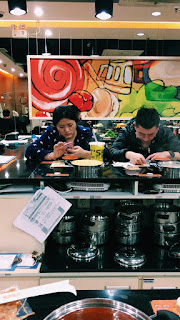…because I love it and no one State-side seems to know about
it.
Xinjiang is the westernmost province in China, roughly the
size of Western Europe. It borders the Middle East, neighboring countries like
Kazakhstan. Because of its proximity to national borders, Xinjiang is home to
many minority groups, namely the Uyghur people. This group, of Turkish decent,
is known for having distinct features, including cultural history and practice.
For hundreds of years, the majority of Uyghur people have been Muslim, having
converted from Buddhism in the ____. Many Uyghur families are traditionally
nomadic peoples, and although that has mostly been left behind, the Uyghur
people are known for their lamb kabobs, raising sheep much like Mongolians.
I’m particularly
hyped about Xinjiang right now, having returned from a trip to Urumqi, Turpan,
and the Bogda Mountains and there are SO many interesting aspects to talk about.
But I’m going to focus on food of course! Xinjiang cuisine is very appealing to
many Westerners because of the similarities with Eastern European foods. It
might be hard to fathom that “Chinese” food could be meat and potatoes, but in
this part of the country, it often is.
Here are a few of my favorite Xinjiang foods:
大盘鸡
(da4pan2ji1) – People love to translate this dish literally as “big plate of
chicken,” which is a pretty accurate description except that it leaves out my
favorite part…the potatoes! Chunks of chicken on the bone, potatoes, onions,
green and red peppers, and garlic are all stewed together in a delicious sauce.
Dapanji also goes great with wide noodles, which will often be brought out
separately and dumped on top of the dish. This is a classic and a must at
Xinjiang restaurants.
串(chuan[r]4) – They come in many forms and are eaten all
over China, but chuanr really are a Xinjiang specialty. Who doesn’t love meat
on a stick?! The most notable kebabs are 羊肉串(yang2rou4chuan4), lamb
kebabs. They are grilled outside and seasoned to your taste, usually with cumin
and chili flakes (辣椒). Pictured to the left, however, is a personal favorite,
鸡肉串(jirouchuan),
chicken kebabs. Though not as common in Xinjiang proper due to a lack of
chickens, many Xinjiang restaurants in Beijing and throughout China will have
them. Delish.
烤馕 (kaonang) – Xinjiang is famous for its breads. They take
many shapes and form, including extremely dense, bagel-like rolls. The most
typical is nang, a round, flat bread, with seasoning that include sesame seeds
or another variety of seeds. While I was in Xinjiang this past week, one of my
favorite things was being able to walk down the street and grab a hot piece of
bread fresh out of the kiln. Watching the vendors make nang is fascinating and
usually involves slapping dough and flinging the finished product like a
Frisbee.
Noodles Noodles Noodles – In Beijing I eat Xinjiang food all
the time but I couldn’t have fathomed what a huge role noodles play in the diet
out west. Everywhere you go there seems to be someone making noodles fresh,
pulling the dough just a few minutes before it winds up on your plate. Try the 拌面 (banmian), a simple dish of noodles, covered with some
veggies and maybe a few cubes of lamb. You won’t regret it!
 Wusu Beer - A little heavier than your average
Chinese beer, Wusu was the go-to Xinjiang beer in the Turpan Depression while I
was there. Many people don’t drink in Xinjiang and beer isn’t served in Muslim
restaurants for the most part, but walking down the grapevine covered streets
of Turpan, there are tons of tables lining the streets outside the convenient
stores covered in beer bottles on a hot afternoon. I’m definitely including
this because I like this picture I took ;) but a cold beer isn’t a bad thing on
a hot day either.
Wusu Beer - A little heavier than your average
Chinese beer, Wusu was the go-to Xinjiang beer in the Turpan Depression while I
was there. Many people don’t drink in Xinjiang and beer isn’t served in Muslim
restaurants for the most part, but walking down the grapevine covered streets
of Turpan, there are tons of tables lining the streets outside the convenient
stores covered in beer bottles on a hot afternoon. I’m definitely including
this because I like this picture I took ;) but a cold beer isn’t a bad thing on
a hot day either. 









